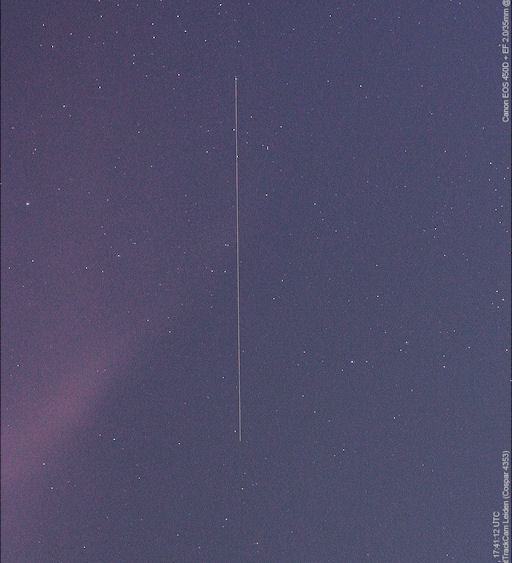Metallic photos of the sun by renowned photographer Greg Piepol bring together the best of art and science. Buy one or a whole set. They make a stellar gift. | | |
CHANCE OF AURORAS: NOAA forecasters estimate a 50% chance of minor geomagnetic storms today as Earth enters a stream of fast-moving solar wind. High-latitude sky watchers should be alert for auroras. Aurora alerts: text, voice.
SATELLITE RE-ENTRY: The ROSAT X-ray observatory, launched in 1990 by NASA and managed for years by the German Aerospace Center (DLR), will return to Earth within the next two weeks. Current best estimates place the re-entry between Oct. 22nd and 24th over an unknown part of Earth. Although ROSAT is smaller and less massive than UARS, which grabbed headlines when it re-entered on Sept. 24th, more of ROSAT could reach the planet's surface. This is because the observatory is made of heat-tolerant materials. According to a DLR study, as many as 30 individual pieces could survive the fires of re-entry. The largest single fragment would likely be the telescope's mirror, which is very heat resistant and may weigh as much as 1.7 tons.
ROSAT is coming, but it's not here yet. On Oct. 13th, Marco Langbroek photographed the observatory still in orbit over Leiden, the Netherlands:

Photo details: 5 second exposure, Canon EOS 450D, ISO 400
"I observed ROSAT this evening in deep twilight," says Langbroek. "It was bright, magnitude +1, and an easy naked-eye object zipping across the sky where the first stars just had become visible."
Update: Scott Tilley of Roberts Creek, British Columbia, made a video of ROSAT on Oct. 15th: "It did get pretty bright, at least 1st magnitude, as it passed overhead after sunset."
ROSAT will become even brighter in the nights ahead as it descends toward Earth. Local flyby times may be found on the web or on your smartphone.
Also, check the German ROSAT re-entry page for updates.
The role of space weather: Solar activity has strongly affected ROSAT's decay. Only a few months ago, experts expected the satellite to re-enter in December. However, they did not anticipate the recent increase in sunspot count. Extreme ultraviolet radiation from sunspots has heated and "puffed up" Earth's atmosphere, accelerating the rate of orbital decay. The massive observatory now has a date with its home planet in October.
Potentially Hazardous Asteroids (
PHAs) are space rocks larger than approximately 100m that can come closer to Earth than 0.05 AU. None of the known PHAs is on a collision course with our planet, although astronomers are finding
new ones all the time.
On October 15, 2011 there were 1250 potentially hazardous asteroids.
Notes: LD means "Lunar Distance." 1 LD = 384,401 km, the distance between Earth and the Moon. 1 LD also equals 0.00256 AU. MAG is the visual magnitude of the asteroid on the date of closest approach. | | The official U.S. government space weather bureau |
| | The first place to look for information about sundogs, pillars, rainbows and related phenomena. |
| | Researchers call it a "Hubble for the sun." SDO is the most advanced solar observatory ever. |
| | 3D views of the sun from NASA's Solar and Terrestrial Relations Observatory |
| | Realtime and archival images of the Sun from SOHO. |
| | from the NOAA Space Environment Center |
| | the underlying science of space weather |
| | for out-of-this-world printing and graphics |

